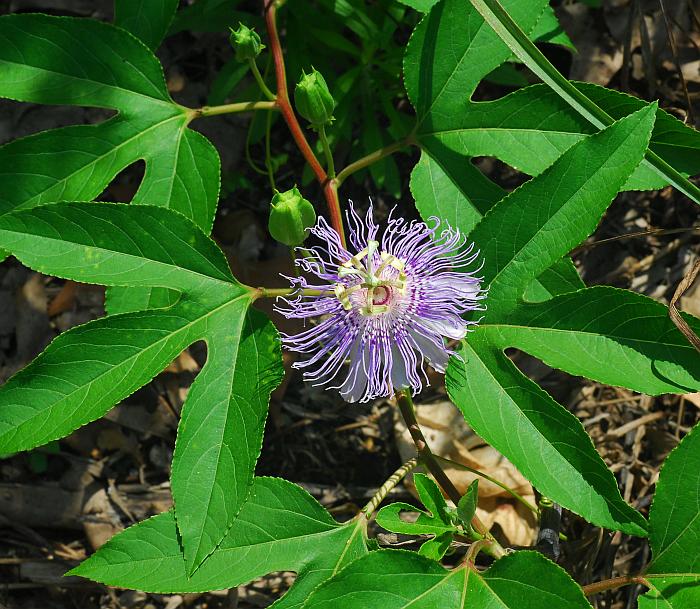Passiflora incarnata L.
Passionflower, May Pops

Native
CC = 2
CW = 5
MOC = 37
© SRTurner
Passiflora incarnata L.Passionflower, May Pops | |
 |
Native CC = 2 CW = 5 MOC = 37 |
© SRTurner |
|
Family - Passifloraceae Habit - Perennial forb. Stems - Vinning, with tendrils, to 10 m, glabrous to minutely pubescent.
Leaves - Alternate, petiolate. Petioles to 3-8 cm long, finely hairy, with two prominent glands near the base of leaf blade. Leaf blades deeply 3-lobed, 6-15 cm long along the midvein, about as long as wide, the lobes usually tapered to a sharp point at the tip, the margins finely glandular-toothed, the upper surface glabrous, dark green, the undersurface sparsely and minutely hairy, lighter green, often also somewhat glaucous. Stipules 2-3 mm long, linear to narrowly lanceolate, withering and sometimes shed as the leaves develop.
Inflorescence - Solitary or paired axial flowers. Flower stalks 4-10 cm long, relatively stout, elongating somewhat at fruiting. Flowers subtended by 2-4 leaflike bracts, these 4-6 mm long, elliptic to oblanceolate, the margins with minute glandular teeth and a pair of larger glands toward the base.
Flowers - 4-9 cm wide. Sepals 5, 25-30 mm long, 6-8 mm wide, narrowly oblong-elliptic, green on the outside, whitish lavender on the inside, each with the midrib having a prominent spur to 5 mm long toward the tip. Petals 5, attached to the rim of the hypanthium and alternating with the sepals, 22-25 mm long, 5-6 mm wide, narrowly oblong-elliptic, white or more commonly pale lavender to lavender. Corona filaments in several series, the outer 2 series similar, 20-30 mm long, filamentous, situated between corolla and petals, pink or lavender to purple with white to whitish yellow crossbands toward the base, the innermost series about 2 mm long, white to whitish yellow with purple tips. Stamens and pistil attached to the tip of a noticeable central stalk (known as the androgynophore, an extension of the receptacle). Stamens 5, inserted at base of ovary, the anthers attached toward the midpoint, pendent. Pistil 1 per flower, composed of 3 fused carpels, with 1 locule and numerous ovules, the placentation parietal. Styles 3, elongate, spreading to somewhat pendant, the stigmas capitate. Ovary densely velvety-hairy.
Fruit - Berries 3-6 cm long, globose to oblong-ellipsoid, greenish yellow to yellowish orange when ripe. Seeds numerous, 4-6 mm long, 3-4 mm wide, obovate in outline, broadly rounded to more or less truncate at the tip, the surface coarsely pitted, white to light brown.
Flowering - June - September. Habitat - Streambanks, bottomland forest margins, moist depressions of upland prairies, fields, fencerows, railroads, roadsides, open disturbed areas. Often in sandy soil. Sometimes cultivated. Origin - Native to the U.S. Lookalikes - None. Other info. - This species with fascinating flowers is found in a number of somewhat scattered counties, mostly south of the Missouri River. In fact, Missouri lies along the northern extent of the plant's natural range in the southeastern quadrant of the continental U.S., and there is some question whether populations north of the Missouri River represent native or introduced occurrences. When in flower, this plant cannot be mistaken for anything else in the state; there is nothing that appears even remotely similar. Photographs taken in Daytona Beach, FL., 7-2-02, and off Lee Rd. 27, Auburn, AL., 7-26-05 (DETenaglia); also at Shaw Nature Reserve, Franklin County, MO, 7-30-2006 and 7-13-2007, along the Katy Trail near the Boone Bridge, St. Charles County, MO, 8-8-2014, and near Pacific Palisades Conservation Area, MO, 7-21-2015 (SRTurner); also in St. Louis, St. Louis County, MO, 9-11-2022 (KBildner). |